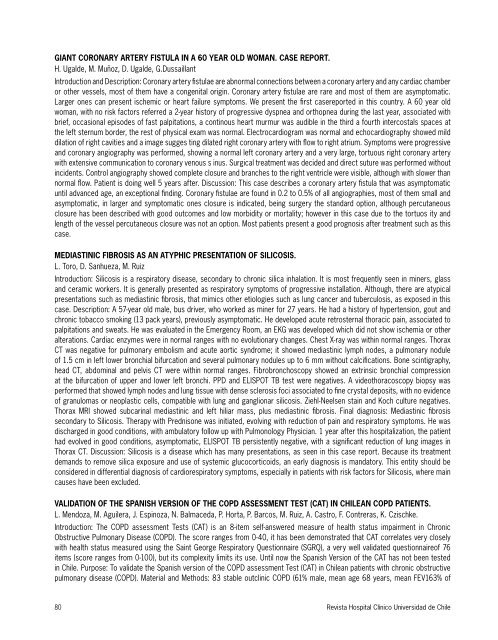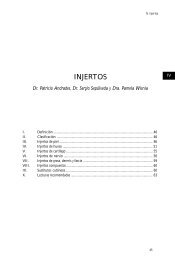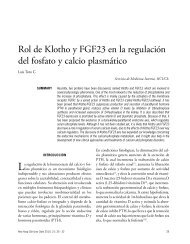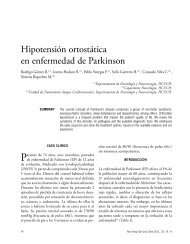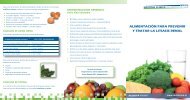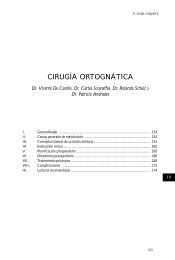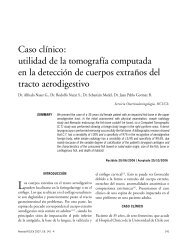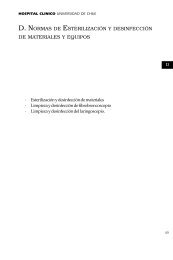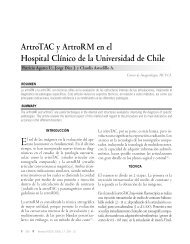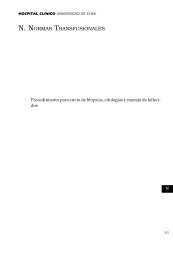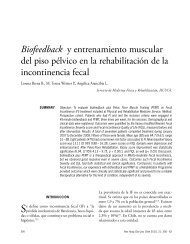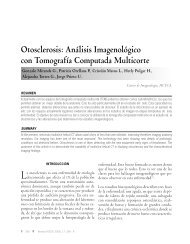Abstracts de trabajos presentados en congresos internacionales 2012
Abstracts de trabajos presentados en congresos internacionales 2012
Abstracts de trabajos presentados en congresos internacionales 2012
Create successful ePaper yourself
Turn your PDF publications into a flip-book with our unique Google optimized e-Paper software.
GIANT CORONARY ARTERY FISTULA IN A 60 YEAR OLD WOMAN. CASE REPORT.H. Ugal<strong>de</strong>, M. Muñoz, D. Ugal<strong>de</strong>, G.DussaillantIntroduction and Description: Coronary artery fistulae are abnormal connections betwe<strong>en</strong> a coronary artery and any cardiac chamberor other vessels, most of them have a cong<strong>en</strong>ital origin. Coronary artery fistulae are rare and most of them are asymptomatic.Larger ones can pres<strong>en</strong>t ischemic or heart failure symptoms. We pres<strong>en</strong>t the first casereported in this country. A 60 year oldwoman, with no risk factors referred a 2-year history of progressive dyspnea and orthopnea during the last year, associated withbrief, occasional episo<strong>de</strong>s of fast palpitations, a continous heart murmur was audible in the third a fourth intercostals spaces atthe left sternum bor<strong>de</strong>r, the rest of physical exam was normal. Electrocardiogram was normal and echocardiography showed milddilation of right cavities and a image sugges ting dilated right coronary artery with flow to right atrium. Symptoms were progressiveand coronary angiography was performed, showing a normal left coronary artery and a very large, tortuous right coronary arterywith ext<strong>en</strong>sive communication to coronary v<strong>en</strong>ous s inus. Surgical treatm<strong>en</strong>t was <strong>de</strong>ci<strong>de</strong>d and direct suture was performed withoutinci<strong>de</strong>nts. Control angiography showed complete closure and branches to the right v<strong>en</strong>tricle were visible, although with slower thannormal flow. Pati<strong>en</strong>t is doing well 5 years after. Discussion: This case <strong>de</strong>scribes a coronary artery fistula that was asymptomaticuntil advanced age, an exceptional finding. Coronary fistulae are found in 0.2 to 0.5% of all angiographies, most of them small andasymptomatic, in larger and symptomatic ones closure is indicated, being surgery the standard option, although percutaneousclosure has be<strong>en</strong> <strong>de</strong>scribed with good outcomes and low morbidity or mortality; however in this case due to the tortuos ity andl<strong>en</strong>gth of the vessel percutaneous closure was not an option. Most pati<strong>en</strong>ts pres<strong>en</strong>t a good prognosis after treatm<strong>en</strong>t such as thiscase.MEDIASTINIC FIBROSIS AS AN ATYPHIC PRESENTATION OF SILICOSIS.L. Toro, D. Sanhueza, M. RuizIntroduction: Silicosis is a respiratory disease, secondary to chronic silica inhalation. It is most frequ<strong>en</strong>tly se<strong>en</strong> in miners, glassand ceramic workers. It is g<strong>en</strong>erally pres<strong>en</strong>ted as respiratory symptoms of progressive installation. Although, there are atypicalpres<strong>en</strong>tations such as mediastinic fibrosis, that mimics other etiologies such as lung cancer and tuberculosis, as exposed in thiscase. Description: A 57-year old male, bus driver, who worked as miner for 27 years. He had a history of hypert<strong>en</strong>sion, gout andchronic tobacco smoking (13 pack years), previously asymptomatic. He <strong>de</strong>veloped acute retrosternal thoracic pain, associated topalpitations and sweats. He was evaluated in the Emerg<strong>en</strong>cy Room, an EKG was <strong>de</strong>veloped which did not show ischemia or otheralterations. Cardiac <strong>en</strong>zymes were in normal ranges with no evolutionary changes. Chest X-ray was within normal ranges. ThoraxCT was negative for pulmonary embolism and acute aortic syndrome; it showed mediastinic lymph no<strong>de</strong>s, a pulmonary noduleof 1.5 cm in left lower bronchial bifurcation and several pulmonary nodules up to 6 mm without calcifications. Bone scintigraphy,head CT, abdominal and pelvis CT were within normal ranges. Fibrobronchoscopy showed an extrinsic bronchial compressionat the bifurcation of upper and lower left bronchi. PPD and ELISPOT TB test were negatives. A vi<strong>de</strong>othoracoscopy biopsy wasperformed that showed lymph no<strong>de</strong>s and lung tissue with <strong>de</strong>nse sclerosis foci associated to fine crystal <strong>de</strong>posits, with no evi<strong>de</strong>nceof granulomas or neoplastic cells, compatible with lung and ganglionar silicosis. Ziehl-Neels<strong>en</strong> stain and Koch culture negatives.Thorax MRI showed subcarinal mediastinic and left hiliar mass, plus mediastinic fibrosis. Final diagnosis: Mediastinic fibrosissecondary to Silicosis. Therapy with Prednisone was initiated, evolving with reduction of pain and respiratory symptoms. He wasdischarged in good conditions, with ambulatory follow up with Pulmonology Physician. 1 year after this hospitalization, the pati<strong>en</strong>thad evolved in good conditions, asymptomatic, ELISPOT TB persist<strong>en</strong>tly negative, with a significant reduction of lung images inThorax CT. Discussion: Silicosis is a disease which has many pres<strong>en</strong>tations, as se<strong>en</strong> in this case report. Because its treatm<strong>en</strong>t<strong>de</strong>mands to remove silica exposure and use of systemic glucocorticoids, an early diagnosis is mandatory. This <strong>en</strong>tity should beconsi<strong>de</strong>red in differ<strong>en</strong>tial diagnosis of cardiorespiratory symptoms, especially in pati<strong>en</strong>ts with risk factors for Silicosis, where maincauses have be<strong>en</strong> exclu<strong>de</strong>d.VALIDATION OF THE SPANISH VERSION OF THE COPD ASSESSMENT TEST (CAT) IN CHILEAN COPD PATIENTS.L. M<strong>en</strong>doza, M. Aguilera, J. Espinoza, N. Balmaceda, P. Horta, P. Barcos, M. Ruiz, A. Castro, F. Contreras, K. Czischke.Introduction: The COPD assessm<strong>en</strong>t Tests (CAT) is an 8-item self-answered measure of health status impairm<strong>en</strong>t in ChronicObstructive Pulmonary Disease (COPD). The score ranges from 0-40, it has be<strong>en</strong> <strong>de</strong>monstrated that CAT correlates very closelywith health status measured using the Saint George Respiratory Questionnaire (SGRQ), a very well validated questionnaireof 76items (score ranges from 0-100), but its complexity limits its use. Until now the Spanish Version of the CAT has not be<strong>en</strong> testedin Chile. Purpose: To validate the Spanish version of the COPD assessm<strong>en</strong>t Test (CAT) in Chilean pati<strong>en</strong>ts with chronic obstructivepulmonary disease (COPD). Material and Methods: 83 stable outclinic COPD (61% male, mean age 68 years, mean FEV163% of80Revista Hospital Clínico Universidad <strong>de</strong> Chile


